Related Research Articles

Improvisational theatre, often called improvisation or improv, is the form of theatre, often comedy, in which most or all of what is performed is unplanned or unscripted, created spontaneously by the performers. In its purest form, the dialogue, action, story, and characters are created collaboratively by the players as the improvisation unfolds in present time, without use of an already prepared, written script.
Improvisation, often shortened to improv, is the activity of making or doing something not planned beforehand, using whatever can be found. Improvisation in the performing arts is a very spontaneous performance without specific or scripted preparation. The skills of improvisation can apply to many different faculties, across all artistic, scientific, physical, cognitive, academic, and non-academic disciplines; see Applied improvisation.

Butoh is a form of Japanese dance theatre that encompasses a diverse range of activities, techniques and motivations for dance, performance, or movement. Following World War II, butoh arose in 1959 through collaborations between its two key founders, Tatsumi Hijikata and Kazuo Ohno. The art form is known to "resist fixity" and is difficult to define; notably, founder Hijikata Tatsumi viewed the formalisation of butoh with "distress". Common features of the art form include playful and grotesque imagery, taboo topics, and extreme or absurd environments. It is traditionally performed in white body makeup with slow hyper-controlled motion. However, with time butoh groups are increasingly being formed around the world, with their various aesthetic ideals and intentions.

South of Market (SoMa) is a neighborhood in San Francisco, California, situated just south of Market Street. It contains several sub-neighborhoods including South Beach, Yerba Buena, and Rincon Hill.
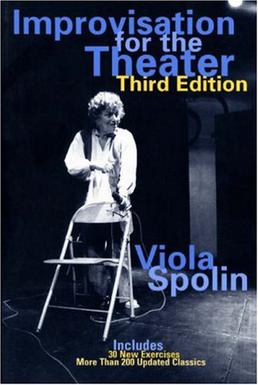
Viola Spolin was an American theatre academic, educator and acting coach. She is considered an important innovator in 20th century American theater for creating directorial techniques to help actors to be focused in the present moment and to find choices improvisationally, as if in real life. These acting exercises she later called Theater Games and formed the first body of work that enabled other directors and actors to create improvisational theater. Her book Improvisation for the Theater, which published these techniques, includes her philosophy and her teaching and coaching methods, and is considered the "bible of improvisational theater". Spolin's contributions were seminal to the improvisational theater movement in the U.S. She is considered to be the mother of Improvisational theater. Her work has influenced American theater, television and film by providing new tools and techniques that are now used by actors, directors and writers.
Jacques Lecoq was a French stage actor and acting movement coach. He was best known for his teaching methods in physical theatre, movement, and mime which he taught at the school he founded in Paris known as École internationale de théâtre Jacques Lecoq. He taught there from 1956 until his death from a cerebral hemorrhage in 1999.

The culture of San Francisco is major and diverse in terms of arts, music, cuisine, festivals, museums, and architecture but also is influenced heavily by Mexican culture due to its large Hispanic population, and its history as part of Spanish America and Mexico. San Francisco's diversity of cultures along with its eccentricities are so great that they have greatly influenced the country and the world at large over the years. In 2012, Bloomberg Businessweek voted San Francisco as America's Best City.
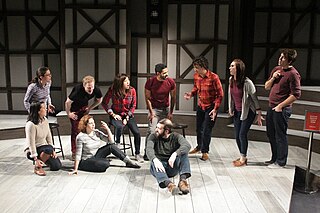
Harold is a structure used in longform improvisational theatre that is performed by improv troupes and teams across the world. In the Harold structure, characters and themes are introduced and then recur in a series of connected scenes. It was first performed in California by The Committee in 1967.
Spontaneous Broadway is an advanced long-form improvised performance, based on audience suggestions. The audience typically submits titles of songs that have never been written, and the performers choose suggestions to create songs, the audience votes through acclamation on their favorite song, which is then used as the core of a brand new Broadway musical.

Émile Jaques-Dalcroze was a Swiss composer, musician, and music educator who developed Dalcroze eurhythmics, an approach to learning and experiencing music through movement. Dalcroze eurhythmics influenced Carl Orff's pedagogy, used in music education throughout the United States.
Applied drama is an umbrella term for the use of theatrical practices and creativity that takes participants and audience members further than mainstream theatre. It is often in response to conventional people with real life stories. The work often happens in non-conventional theatre spaces and social settings. There are several forms and practices considered to be under the umbrella of applied theatre.
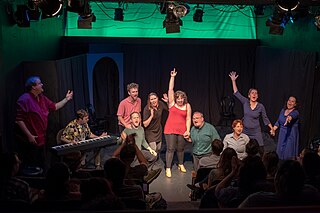
Un-Scripted Theater Company® is an improvisational theater company in San Francisco, California. Un-Scripted Theater Company performs many kinds of improv formats, such as comedy, mystery, drama, adventure, and musicals, each presented in 4 to 6 week runs each season, each with its own Director, format, and vision. Un-Scripted specializes in narrative and genre-based "single-story" improvised theater.

Anna Halprin was an American choreographer and dancer. She helped redefine dance in postwar America and pioneer the experimental art form known as postmodern dance and referred to herself as a breaker of the rules of modern dance. In the 1950s, she established the San Francisco Dancers' Workshop to give artists like her a place to practice their art. Exploring the capabilities of her own body, she created a systematic way of moving using kinesthetic awareness. With her husband, landscape architect Lawrence Halprin, she developed the RSVP cycles, a creative methodology that includes the idea of scores and can be applied broadly across all disciplines. Many of her creations have been scores, including Myths in the 1960s which gave a score to the audience, making them performers as well, and a highly participatory Planetary Dance (1987). Influenced by her own battle with cancer and her healing journey, Halprin became known for her work with the terminally ill patients as well as creative movement work in nature.
The Committee was a San Francisco-based improvisational comedy group founded by Alan Myerson and Jessica Myerson. The Myersons were both alums of The Second City in Chicago. The Committee opened April 10, 1963 at 622 Broadway in a 300-seat Cabaret theater that used to be an indoor bocce ball court in San Francisco's North Beach.
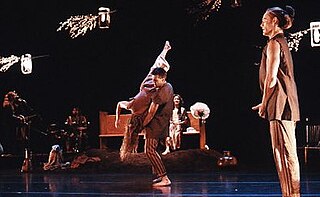
Contraband, a collection of artists led by director/choreographer Sara Shelton Mann, was a dance-based, live performance ensemble, working together from 1985 to the mid '90s. Based mainly in San Francisco, the group became known for its lively, electrifying performances, often politically charged and community-engaging. By utilizing dance, music, set, text/spoken word, and site-specific work, Contraband came to develop a cross-disciplinary performance aesthetic, as well as approach to dance and dance training, that would have a profound influence on Bay Area dance, performance art, and culture, as well as performance practice abroad.

Z Space is a regional theater and performing arts company located in the Mission District of San Francisco, California. Z Space is one of the leading laboratories for developing new voices, new works, and new opportunities in the American theater. In addition to commissioning and producing its own works, Z Space also presents productions created by other organizations.

Somatics is a field within bodywork and movement studies which emphasizes internal physical perception and experience. The term is used in movement therapy to signify approaches based on the soma, or "the body as perceived from within", including Skinner Releasing Technique, Alexander technique, the Feldenkrais Method, and Rolfing Structural Integration. In dance, the term refers to techniques based on the dancer's internal sensation, in contrast with "performative techniques", such as ballet or modern dance, which emphasize the external observation of movement by an audience. Somatic techniques may be used in bodywork, psychotherapy, dance, or spiritual practices.
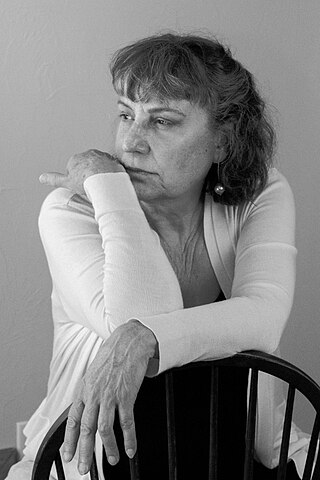
Mary Overlie was an American choreographer, dancer, theater artist, professor, author, and the originator of the Six Viewpoints technique for theater and dance. The Six Viewpoints technique is both a philosophical articulation of postmodern performance and a teaching system addressing directing, choreographing, dancing, acting, improvisation, and performance analysis. The Six Viewpoints has been taught in the core curriculum of the Experimental Theater Wing within Tisch School of the Arts at New York University since its inception (1978).
Kathleen Hermesdorf was a dancer, teacher, choreographer, improviser, producer, and curator, born in Wisconsin, USA, and a long-time resident of San Francisco.
References
- ↑ Kourlas, Gia (2011-10-31). "Improviser With a Touch of 'I Love Lucy'". The New York Times. ISSN 0362-4331 . Retrieved 2023-01-31.
- ↑ Morrow, S. (2011). Psyche meets Soma: accessing creativity through Ruth Zaporah’s Action Theater. Theatre, Dance and Performance Training, 2(1), 99–113. doi:10.1080/19443927.2010.543987
- ↑ Zaporah, R. (1995). Action Theatre: the improvisation of presence. Berkeley, CA: North Atlantic Books. ISBN 978-1556431869
- ↑ Morrow, S. (2011). Psyche meets Soma: accessing creativity through Ruth Zaporah’s Action Theater. Theatre, Dance and Performance Training, 2(1), 99–113. doi:10.1080/19443927.2010.543987
- ↑ Hurwitt, R. (2009, July 10). Date Lines: News from the Bay Area arts scene. San Francisco Chronicle. Retrieved from http://www.sfchronicle.com/bayarea/article/Date-Lines-News-from-the-Bay-Area-arts-scene-3226067.php
- ↑ Off the cuff: Ruth Zaporah proves that preparation isn’t always best. (2006, September 13). Santa Fe Reporter. Retrieved from http://www.sfreporter.com/santafe/article-927-off-the-cuff.html